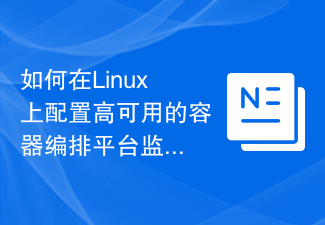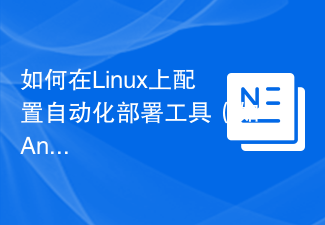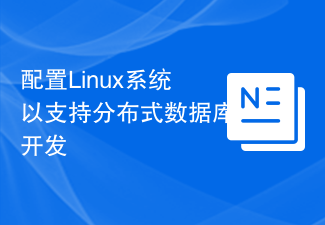 Operation and Maintenance
Operation and Maintenance Linux Operation and Maintenance
Linux Operation and Maintenance Configuring Linux systems to support container cloud development
Configuring Linux systems to support container cloud developmentConfiguring Linux systems to support container cloud development
Container Cloud Development (Container Cloud Development) is a technology that isolates application development and deployment environments from each other. It uses containerization technology to package applications and their dependencies into images, which are managed and deployed uniformly through the container management platform. In the process of configuring a container cloud development environment on a Linux system, we will use Docker and Kubernetes, two popular open source tools.
The following are the steps and related code examples to configure a Linux system to support container cloud development.
Step 1: Install Docker
Docker is a containerization platform, we first need to install it.
# 更新包管理工具 sudo apt-get update # 安装Docker依赖项 sudo apt-get install -y apt-transport-https ca-certificates curl software-properties-common # 添加Docker官方GPG密钥 curl -fsSL https://download.docker.com/linux/ubuntu/gpg | sudo apt-key add - # 添加Docker软件源 sudo add-apt-repository "deb [arch=amd64] https://download.docker.com/linux/ubuntu $(lsb_release -cs) stable" # 更新包管理工具 sudo apt-get update # 安装Docker sudo apt-get install -y docker-ce
Step 2: Configure the Docker image accelerator
In order to speed up the speed of Docker pulling images, we can configure the Docker image accelerator.
# 创建或编辑Docker配置文件 sudo nano /etc/docker/daemon.json
In the opened file, add the following content (assuming we choose to use Alibaba Cloud as the image accelerator):
{
"registry-mirrors": ["https://[YOUR_REGION_ID].mirror.aliyuncs.com"]
}After saving the file, restart the Docker service to make the configuration take effect.
sudo systemctl restart docker
Step 3: Install Kubernetes
Kubernetes is a container orchestration platform used to manage and schedule containerized applications.
# 安装Kubernetes依赖项 sudo apt-get install -y apt-transport-https curl -s https://packages.cloud.google.com/apt/doc/apt-key.gpg | sudo apt-key add - sudo echo "deb http://apt.kubernetes.io/ kubernetes-xenial main" | sudo tee /etc/apt/sources.list.d/kubernetes.list # 更新包管理工具 sudo apt-get update # 安装Kubernetes sudo apt-get install -y kubelet kubeadm kubectl
Step 4: Initialize the Kubernetes master node
In the Kubernetes cluster, a node is designated as the master node (Master). We need to initialize this master node.
# 初始化主节点 sudo kubeadm init --pod-network-cidr=10.244.0.0/16
After the initialization is completed, Kubernetes will provide some commands for us to use when deploying nodes later. Make a note of these commands, we will use them in the next steps.
Step 5: Install the network plug-in
In the Kubernetes cluster, we need to install the network plug-in to enable containers to communicate with each other.
# 安装网络插件(这里以Flannel为例) sudo kubectl apply -f https://raw.githubusercontent.com/coreos/flannel/master/Documentation/kube-flannel.yml
Step 6: Join nodes
Now, we will add other Linux system nodes to the Kubernetes cluster.
# 在主节点执行步骤4的命令中,复制并运行输出的kubeadm join命令。 # 在其他节点上运行kubeadm join命令以加入集群。
At this point, we have completed the process of configuring the Linux system to support container cloud development. Now you can start deploying and managing your applications using the benefits of container cloud development!
Summary
By configuring a Linux system to support container cloud development, we can easily leverage containerization technology to manage and deploy applications. With the help of Docker and Kubernetes, two powerful open source tools, we can develop and operate more efficiently. I hope the steps and code examples provided in this article are helpful!
The above is the detailed content of Configuring Linux systems to support container cloud development. For more information, please follow other related articles on the PHP Chinese website!
 配置Linux系统以支持智能机器人和自动化设备开发Jul 05, 2023 am 11:46 AM
配置Linux系统以支持智能机器人和自动化设备开发Jul 05, 2023 am 11:46 AM配置Linux系统以支持智能机器人和自动化设备开发智能机器人和自动化设备在现代科技领域中扮演着重要的角色,它们能够帮助人们完成繁重、危险或重复的工作,提高生产效率和工作质量。而作为一个开发者,要支持这些应用的开发,就需要配置Linux系统,以能够正确运行和管理这些智能机器人和自动化设备。本文将介绍如何配置Linux系统以支持智能机器人和自动化设备开发,并附上
 如何在Linux上配置高可用的容器编排平台监控Jul 06, 2023 pm 07:17 PM
如何在Linux上配置高可用的容器编排平台监控Jul 06, 2023 pm 07:17 PM如何在Linux上配置高可用的容器编排平台监控随着容器技术的发展,容器编排平台作为管理和部署容器化应用的重要工具,被越来越多的企业所采用。为保证容器编排平台的高可用性,监控是非常重要的一环,它可以帮助我们实时了解平台的运行状态、快速定位问题并进行故障恢复。本文将介绍如何在Linux上配置高可用的容器编排平台监控,并提供相关的代码示例。一、选择合适的监控工具在
 配置Linux系统以支持图像处理与计算机视觉开发Jul 04, 2023 pm 10:13 PM
配置Linux系统以支持图像处理与计算机视觉开发Jul 04, 2023 pm 10:13 PM配置Linux系统以支持图像处理与计算机视觉开发在当今的数字时代,图像处理与计算机视觉在各个领域中都扮演着重要的角色。为了进行图像处理和计算机视觉开发,我们需要在我们的Linux系统上进行一些配置。本文将向您介绍如何配置您的Linux系统以支持这些应用,并提供一些代码示例。一、安装Python和相应的库Python是一种广泛使用的编程语言,适用于图像处理和计
 如何在Linux上配置自动化部署工具(如Ansible)Jul 07, 2023 pm 05:37 PM
如何在Linux上配置自动化部署工具(如Ansible)Jul 07, 2023 pm 05:37 PM如何在Linux上配置自动化部署工具(如Ansible)引言:在软件开发和运维过程中,经常会遇到需要将应用程序部署到多台服务器上的情况。手动部署无疑效率低下且容易出错,因此配置一个自动化部署工具是必不可少的。本文将介绍如何在Linux上配置一个常用的自动化部署工具——Ansible,以实现快速、可靠的应用程序部署。一、安装Ansible打开终端,使用以下命令
 配置Linux系统以支持分布式数据库开发Jul 04, 2023 am 08:24 AM
配置Linux系统以支持分布式数据库开发Jul 04, 2023 am 08:24 AM配置Linux系统以支持分布式数据库开发引言:随着互联网的迅猛发展,数据量急剧增加,对数据库的性能和扩展性要求也越来越高。分布式数据库成为了应对这一挑战的解决方案。本文将介绍如何在Linux系统下配置分布式数据库环境,以支持分布式数据库开发。一、安装Linux系统首先,我们需要安装一个Linux操作系统。常见的Linux发行版有Ubuntu、CentOS、D
 配置Linux系统以支持大数据处理和分析Jul 04, 2023 pm 08:25 PM
配置Linux系统以支持大数据处理和分析Jul 04, 2023 pm 08:25 PM配置Linux系统以支持大数据处理和分析摘要:随着大数据时代的到来,对于大数据的处理和分析需求越来越大。本文将介绍如何在Linux系统上进行配置,以支持大数据处理和分析的应用程序和工具,并提供相应的代码示例。关键词:Linux系统,大数据,处理,分析,配置,代码示例引言:大数据作为一种新兴的数据管理和分析技术,已经广泛应用于各个领域。为了保证大数据处理和分析
 如何在Linux上配置分布式文件系统Jul 05, 2023 pm 10:49 PM
如何在Linux上配置分布式文件系统Jul 05, 2023 pm 10:49 PM如何在Linux上配置分布式文件系统引言:随着数据量的不断增长和业务需求的不断变化,传统的单机文件系统已经无法满足现代大规模数据处理的需求。分布式文件系统因其高可靠性、高性能和可扩展性而成为大型数据中心的首选。本文将介绍如何在Linux上配置一个常见的分布式文件系统,并附上代码示例。一、分布式文件系统简介分布式文件系统是将数据分散储存在多个节点上,并通过网络
 如何在Linux上配置本地代码仓库(如GitLab)Jul 09, 2023 pm 07:04 PM
如何在Linux上配置本地代码仓库(如GitLab)Jul 09, 2023 pm 07:04 PM如何在Linux上配置本地代码仓库(如GitLab)引言:代码管理是软件开发过程中至关重要的一环。在日常的开发工作中,我们需要有一个可靠的代码仓库来管理我们的代码版本,并与团队成员共享和协作。GitLab是一款强大的开源代码托管管理平台,它提供了许多功能,如版本控制、代码审查、持续集成等。本文将介绍如何在Linux系统上配置本地的代码仓库,以及如何使用Git


Hot AI Tools

Undresser.AI Undress
AI-powered app for creating realistic nude photos

AI Clothes Remover
Online AI tool for removing clothes from photos.

Undress AI Tool
Undress images for free

Clothoff.io
AI clothes remover

AI Hentai Generator
Generate AI Hentai for free.

Hot Article

Hot Tools

SublimeText3 English version
Recommended: Win version, supports code prompts!

VSCode Windows 64-bit Download
A free and powerful IDE editor launched by Microsoft

MantisBT
Mantis is an easy-to-deploy web-based defect tracking tool designed to aid in product defect tracking. It requires PHP, MySQL and a web server. Check out our demo and hosting services.

WebStorm Mac version
Useful JavaScript development tools

EditPlus Chinese cracked version
Small size, syntax highlighting, does not support code prompt function




